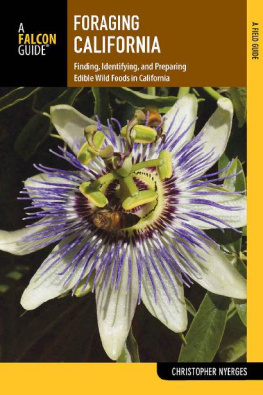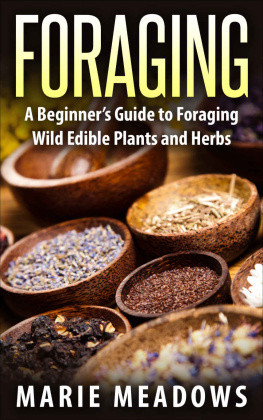Contents
Foraging New York
Finding, Identifying, and Preparing
Edible Wild Foods
Wildman Steve Brill


An imprint of Globe Pequot
Falcon, FalconGuides, and Outfit Your Mind are registered trademarks of Rowman & Littlefield.
Distributed by NATIONAL BOOK NETWORK
Copyright 2017 Rowman & Littlefield
Map by Melissa Baker Rowman & Littlefield
All interior photographs by Steve Brill unless otherwise noted
All rights reserved . No part of this book may be reproduced in any form or by any electronic or mechanical means, including information storage and retrieval systems, without written permission from the publisher, except by a reviewer who may quote passages in a review.
British Library Cataloguing-in-Publication Information available
Library of Congress Cataloging-in-Publication Data
Names: Brill, Steve.
Title: Foraging New York: Finding, Identifying, and Preparing Edible Wild Foods / Steve Brill.
Description: Guilford, Connecticut : FalconGuides, [2017] | Includes index.
Identifiers: LCCN 2016046004 (print) | LCCN 2016046705 (ebook) | ISBN 9781493024292 (pbk.) | ISBN 9781493024292 (e-book)
Subjects: LCSH: Wild plants, EdibleNew York (State) | Plants, EdibleNew York (State)
Classification: LCC QK98.5.U6 B748 2017 (print) | LCC QK98.5.U6 (ebook) | DDC 581.6/32097471dc23
LC record available at https://lccn.loc.gov/2016046004
 The paper used in this publication meets the minimum requirements of American National Standard for Information SciencesPermanence of Paper for Printed Library Materials, ANSI/NISO Z39.48-1992.
The paper used in this publication meets the minimum requirements of American National Standard for Information SciencesPermanence of Paper for Printed Library Materials, ANSI/NISO Z39.48-1992.
Printed in the United States of America
To all the wonderful people who attended my foraging tours over the decades, spread their love of nature, and helped make our planet a greener place.

Contents
Acknowledgments
I want to thank my daughter, foraging expert Violet Brill, for her curiosity and perceptiveness in the field, and in the kitchen. She discovered new ways to use several of the plants in this book that would never have occurred to me, and also contributed recipe ideas starting from when she was a very young child.
I also want to thank Wisteria, Violet's parakeet, for flying onto my shoulder, talking into my ear, and dictating everything I should write in this book!
Introduction
About Foraging
Dozens of edible wild plants grow, unnoticed, in virtually every possible habitat throughout New York State. Many of these are so common, or even invasive, that people destroy them as weeds, although, in fact, they're more tasty and nutritious than anything you can buy from a store.
Here's how you can discover and identify them, harvest them ecologically and safely, and use them to make delicious, healthful recipes, as well as home remedies. This is based on my experience as a naturalist and an environmental educator who has been leading thousands of foraging tours. I've worked with the public, and with schools, day camps, museums, nature centers, land trusts, farmer's markets, teaching farms, parks departments, and other organizations throughout the Greater New York Region since 1982. I' also draw on extensive research, and collaboration with other foragers.
You'll learn to enjoy our incredible bounty of wild herbs, shoots, greens, fruits, berries, roots, nuts, seeds, flowers, and even seaweeds in the field and in the kitchen. These species are really good to eat and practical to collect, not the ones that take forever to collect and process and result in tiny amounts of food that tastes so bad, you'd wish there was still less!
I chose these species not only because they're the ones I know best, but also because they're common, widespread, and easy to harvest ecologically. Also, they're fun and easy to use for making some great meals.
Ground Rules
The first thing to know about foraging is that you need to identify anything you're going to eat with 100 percent certainty before you eat it. Each plant has key identifying characteristics that let you distinguish it from all other plants. When you think you've found a plant from this book, carefully go over every single characteristic the plant should have at the time of year you're collecting it, one by one. If the characteristics aren't there, don't eat the plant. You can keep following it throughout the seasons as different features appear and try it later on, when you're completely sure you have the right plant.
Poisonous Plants
Some poisonous plants resemble edible plants. I warn about these in the text and describe the features that distinguish the two species. Seek out those attributes. If you're a novice, learn the most common species that lack toxic look-alikes and follow them through their life cycles. If you're not sure, be patient.
No one was teaching foraging when I began in 1982, so I had to learn everything by myself. Using field guides full of inaccuracies and mistakes, written by botanists who didn't forage or cook, I was still able to identify Kentucky coffee tree and greenbrier (see p. 82) right away, but had to wait almost 2 years before I could eat daylily (see p. 23) shoots safely, and even longer before I found out that cornelian cherrieswhich no foraging book coveredwere actually edible.
Be especially careful not to collect a different plant that's growing along with an edible species. It doesn't help if the characteristics are completely different if you don't notice that you've picked two different species. (See the story under lamb's quarters [p. 127] for an extreme example of this.)
Pollution
Plants can pick up pollution from the environment. Quickly growing leaves and stems are good at this, while fruits, nuts, and seeds pick up the least contamination.
Avoid obvious polluted places. Heavy metals tend to settle within 50 feet of heavy traffic and persist in the soil, even decades later. Arsenic was used before DDT, for spraying fruit in orchards, and that's still around in those places too. Railroads spray toxic herbicides around their tracks, so avoid foraging near those. Golf courses are just as bad. Disheveled-looking old buildings, which look like sites where people dumped all sorts of toxic substances, are obvious places to avoid. The same is true in the vicinity of farms that use toxic chemicals on their crops. Polluted waterways should also be avoided.
Rinse off everything you take home under running water, and use common sense to avoid foraging from sites that are likely to be contaminated. Most of the plants in this book are so common, once you've learned them, you should be able to find them in unspoiled natural habitats.
Plant Names
Common names are ambiguous and vary regionally, so two different plants may have the same name. Scientific names are hard to memorize, but you can look them up in this book and use them as references, to make sure you don't get poisoned by nomenclature! Family names are included too, as members of plant families have some common characteristics, especially their reproductive parts (which is why they were put into one family in the first place), making it easier to get a handle on all the botanical diversity you're going to encounter. All members of the legume family, for example, have pods that look recognizably like a variant of peapods.











 The paper used in this publication meets the minimum requirements of American National Standard for Information SciencesPermanence of Paper for Printed Library Materials, ANSI/NISO Z39.48-1992.
The paper used in this publication meets the minimum requirements of American National Standard for Information SciencesPermanence of Paper for Printed Library Materials, ANSI/NISO Z39.48-1992.